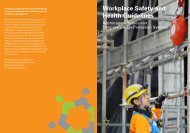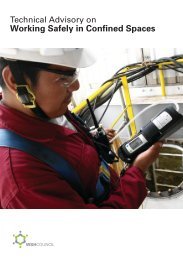Download - Workplace Safety and Health Council
Download - Workplace Safety and Health Council
Download - Workplace Safety and Health Council
Create successful ePaper yourself
Turn your PDF publications into a flip-book with our unique Google optimized e-Paper software.
EVENts7Singaporesigns theSeoulDeclarationMeeting of MindsThrough the various plenary sessions<strong>and</strong> symposiums, attendees heard fromprominent local <strong>and</strong> international speakersabout effective WSH management, <strong>and</strong>ideal WSH approaches through case studies<strong>and</strong> best practices. The Conference alsofeatured sessions focused on small <strong>and</strong>medium enterprises (SMEs), to help themdiscover how implementing WSH makesgood business sense <strong>and</strong> increase profit.Keynote speaker Dr Sachiko Yamamoto,Regional Director of ILO’s Asia-PacificRegional Office, shared a global perspectiveon the challenges <strong>and</strong> efforts to protect thesafety <strong>and</strong> health of workers amidst thediverse <strong>and</strong> complex work environments inglobalising economies. Country delegateshighlighted their experiences in WSH, withSingapore sharing our tripartite approach —employers, unions <strong>and</strong> government together— to manage WSH.The Business of <strong>Safety</strong>For the business aspect, CEO speakers offeredvaluable insights in safety leadership <strong>and</strong>managing the supply chain for better WSHoutcomes <strong>and</strong> hence business profitability<strong>and</strong> productivity. WSH professionals sharedtheir WSH challenges on the ground, <strong>and</strong>their experiences in implementing innovativeWSH practices across organisations.Emphasising the role of WSH professionals inSMEs in driving improvements in workplacesafety, former U.S. Assistant Secretary ofLabor for Occupational <strong>Safety</strong> <strong>and</strong> <strong>Health</strong>Administration <strong>and</strong> leading expert, Mr JohnHenshaw, highlighted that “SMEs havediscovered how to create additional socioeconomicvalue through worker protectionwhich improves their competitive position inthe global marketplace.”The wealth of experience <strong>and</strong> talentgathered during the Conference alsofacilitated the constructive sharing ofinsights. Conference participant, Mr LimSui Soon, Director of <strong>Health</strong> <strong>Safety</strong> SecurityEnvironment from Cameron (S) Pte Ltdnoted,: “This conference offers a good <strong>and</strong>rare opportunity to listen to internationalexperts from different parts of the world toshare with us, what they do as a nationallevel, at their individual trade associationlevels <strong>and</strong> also as a region like the EU.“Technological, social <strong>and</strong> economic changeswill continue to effect tremendous shifts inthe WSH l<strong>and</strong>scape in the coming years. TheSingapore WSH Conference is well-placed toserve the region, through cross-fertilisationof ideas <strong>and</strong> generation of new insights fromexperts, practitioners <strong>and</strong> policy makers.Mr Lee Tzu Yang (left), Chairman, WSH <strong>Council</strong>, pictured withMr Lee Joon-Won (right), Secretary-General, InternationalCooperation Center, Secretariat for Seoul Declaration on <strong>Safety</strong> <strong>and</strong><strong>Health</strong> at Work, Korea Occupational <strong>Safety</strong> <strong>and</strong> <strong>Health</strong> AgencyThe Seoul Declaration, supported by theInternational Labour Organization, servesas a major new blueprint for constructing aglobal culture of safety <strong>and</strong> health at work.The Declaration upholds the right to a safe<strong>and</strong> healthy working environment as afundamental human right, <strong>and</strong> considers thatimproving safety <strong>and</strong> health at work hasa positive impact on working conditions,productivity, economic <strong>and</strong> socialdevelopment.Singapore became a signatory of the SeoulDeclaration on 15 September 2010 at theSingapore WSH Conference. While alreadyevident in the many national efforts in WSHinitiatives effected in recent years, thisformal commitment elevates Singapore’sprofile in WSH on an international level.The Seoul Declaration is a key conjunctiveelement of the next three World Congress on<strong>Workplace</strong> <strong>and</strong> <strong>Safety</strong> <strong>and</strong> will culminate atthe 2017 Congress to be hosted in Singapore.More than 200 organisations worldwide havesigned the Seoul Declaration. For a full list,please visit http://bit.ly/seouldeclaration
events9Let’s Talk <strong>Safety</strong>:Logistics <strong>and</strong> Transport <strong>Safety</strong>Champions League 2010Communication is crucial when it comes to all areas of work in the Logistics <strong>and</strong> Transport(L&T) sector. From operating heavy machinery, loading <strong>and</strong> unloading of goods, orundertaking comprehensive risk assessment, communication opens the way towardsa healthier <strong>and</strong> safer work environment for all. This is the key focus of the L&T <strong>Safety</strong>Champions League 2010, held on 26 September 2010 at Big Splash in East Coast.Let’s Talk StatisticsA total of 200,000 people areemployed in the L&T sector; <strong>and</strong> some500 workers were injured from workincidents in 2009. This works out tobe more than one injury each day. Tohelp workplaces put in place bettersafety measures, the <strong>Workplace</strong> <strong>Safety</strong><strong>and</strong> <strong>Health</strong> (WSH) <strong>Council</strong> issuedguidelines on <strong>Workplace</strong> Traffic <strong>Safety</strong>Management <strong>and</strong> Safe Loading inVehicles last year.Let’s Talk <strong>Safety</strong>Reiterating the importance ofcommunication, Guest-of-Honour,Mr Hawazi Daipi, Senior ParliamentarySecretary (Manpower <strong>and</strong> <strong>Health</strong>),said: "While the guidelines willhelp employers put in place safetymeasures, what is most important isthat everyone underst<strong>and</strong>s <strong>and</strong> takesthe steps to ensure safety. This is whytoday’s L&T <strong>Safety</strong> Champions Leagueadopted the theme "Let’s Talk <strong>Safety</strong>".You must underst<strong>and</strong> the workplacerisks <strong>and</strong> the measures needed toprevent such risks from affecting you<strong>and</strong> your co-workers. Today’s leagueactivity therefore highlights theimportance of good communications,the ability to underst<strong>and</strong> <strong>and</strong> workcohesively <strong>and</strong> safely as one team atall levels – from the top managementto the workers on the ground."The highlight of the event wasthe forklift relay races with 16participating teams from theL&T sector. The race showcasedthe importance of teamwork,communication, strategy <strong>and</strong> skill atwork as competing teams raced tothe finish line in their bid to make itto the finals. The championship cameto a nail-biting final race, with TeamBS (from Bok Seng Logistics Pte Ltd)achieving a well-deserved victory withtheir precise maneuvering of theirforklift <strong>and</strong> skillful team coordination.L&T <strong>Safety</strong> Champions League 2010was organised by the WSH <strong>Council</strong>in collaboration with the Ministryof Manpower. It was sponsored byLTH Logistics (S) Pte Ltd <strong>and</strong> PSACorporation Ltd <strong>and</strong> supported byGoldbell Leasing Pte Ltd <strong>and</strong> PUB.
EVENTS11WSH COURSESWorkshop to Enhance <strong>Safety</strong> of Crane OperationsCranes are widely used on construction sites <strong>and</strong> can pose a serious danger if they are not safelyoperated. To raise the safety competencies of all personnel involved in the operations of cranes, theMinistry of Manpower requires all crane operators to attend this workshop before their license renewalwith effect from 1 April 2011.The Workshop will update crane operators with the latest legal requirements as well as to providethem a platform to discuss safe lifting procedures <strong>and</strong> case studies which identify causes of craneaccidents. Topics covered include safety practices for crane operations, updates on safety laws <strong>and</strong>regulations, safe lifting practices <strong>and</strong> lessons learnt from recent crane-related accidents.For further enquiries pertaining to the enrolment in the Workshop, please contact the followingtraining providers:• BCA Academy of the Built Environment • NTUC Learning HubKristeen LeeOng Zhi XianTel: 6248 9868 Tel: 6795 2541Design for <strong>Safety</strong>: Project <strong>Safety</strong> <strong>and</strong> Coordinator CourseEffective coordination <strong>and</strong> communication between clients, designers <strong>and</strong> contractors is essential toreduce safety <strong>and</strong> health risks in every construction work. To ensure continuity in information flow, asuitably qualified Project <strong>Safety</strong> <strong>and</strong> <strong>Health</strong> Coordinator (PSHC) is required to follow through a projectfrom the design stage, to the construction stage until the h<strong>and</strong>over to the client for maintenance.To meet the rising dem<strong>and</strong> for a pool of competent professionals to undertake the PSHC role, wehave launched the Design for <strong>Safety</strong>: Project <strong>Safety</strong> <strong>and</strong> Coordinator Course. Supported by variousassociations including the Singapore Institute of Architects (SIA) <strong>and</strong> the Singapore ContractorsAssociation Limited (SCAL), this 2-day course is targeted at experienced design <strong>and</strong> constructionprofessionals with safety <strong>and</strong> health knowledge. For details on upcoming courses, pleasevisit Ministry of Manpower’s website at www.mom.gov.sgWork-at-Height (WAH) Course for SupervisorsSupervisors play a critical role to reduce Work-at-Height risks in workplaces as they are directlyresponsible for many workers on the ground <strong>and</strong> can make the most immediate impact to how workis carried out. To build capabilities in this key area, a new <strong>and</strong> first-of-its-kind training programme,the WAH Course for Supervisors, has been launched since July 2010. This 2-day course, comprisingtheoretical <strong>and</strong> practical aspects, will bring supervisors through a wide range of topics such as fallprotection systems, risk assessment, safe work procedures, as well as emergency planning. To sign upfor this course or view more details, please visit our accredited training providers as follows:• Asretec Pte Ltdwww.asretec.org• QMT Industrial<strong>and</strong> <strong>Safety</strong> Pte Ltdwww.qmtsafety.com• Capital <strong>Safety</strong> Group Asia Pte Ltdwww.capitalsafety.com
14Fact FileHearing ConservationProgrammeNoise-induced hearing loss (NIHL) continues to be the leading occupational disease in Singapore. Itis often undetected because there are no visible symptoms, develops gradually over a long periodof time, <strong>and</strong> seldom causes pain except in rare situations of extreme exposure. NIHL is irreversiblebut preventable. Under the <strong>Workplace</strong> <strong>Safety</strong> <strong>and</strong> <strong>Health</strong> (Noise) Regulations, employers have anobligation to protect their workers who are exposed to hazardous noise levels in the workplace.Hearing ConservationProgramme (HCP)To protect employees from the harmfuleffects of excessive noise, every workplacewith noise hazards should implementa comprehensive HCP as part of thecompany’s safety <strong>and</strong> health programme.Implementation of a HCP is based on thefact that NIHL is preventable. Therefore, theobjective of a HCP is to minimise the risksassociated with excessive <strong>and</strong>/or extendednoise exposure <strong>and</strong> to prevent hearing lossat the workplace.Components of a HCPIdentification of noise hazards <strong>and</strong> riskassessmentA HCP consists of several parts startingwith detecting <strong>and</strong> mapping out thehazardous noise in the workplace.Under the <strong>Workplace</strong>, <strong>Safety</strong> <strong>and</strong> <strong>Health</strong>(Risk Management) Regulations, a riskassessment must be conducted <strong>and</strong>documented for all work activities, includingnoisy processes, before work commences.The first phase of the risk assessmentbegins with hazard identification toidentify noisy work processes, type ofnoise generated, persons exposed, theirduration <strong>and</strong> level of exposure.Noise ControlWhen a noise hazard existsat the workplace, the secondphase of risk assessmentrequires reasonably practicablecontrol measures to betaken to reduce the risk toan acceptable level. Thehierarchy of control measurescan be used as a guide toachieve this objective.See Figure 1:Safe<strong>Workplace</strong>SafeWorkerHearing ProtectionUse of hearing protective devices (HPD) isthe last resort to control noise exposurewhen substitution <strong>and</strong> engineering controlsare not feasible. Use of HPD does not reduceor eliminate the hazard; it only protects thewearer. Where use of HPD is required, it isimportant to communicate their proper use,care, maintenance <strong>and</strong> limitations to affectedemployees. For more information on use ofHPD, refer to SS 549:2009 Code of Practicefor Selection, use, care <strong>and</strong> maintenance ofhearing protectors.Employee Training <strong>and</strong> EducationThe objective of training is to increasethe employees’ awareness of the hazardsof noise <strong>and</strong> what they need to do toprevent NIHL. Development of training<strong>and</strong> education materials <strong>and</strong> HPD selectioninvolving workers would give them a senseof ownership <strong>and</strong> motivation to participatein the program. Training should alsoperiodically include correct wearing, fitting<strong>and</strong> maintenance of HPD <strong>and</strong> ensure they arestill appropriate for the area in which theyare worn.Audiometric ExaminationAudiometric evaluation of workers’ hearing isthe only way to actually determine whetheroccupational hearing loss is being prevented.Under the WSH (Medical Examinations)EliminationSubstitutionEngineering ControlsAdministrative ControlsUse of Personal Protective EquipmentFigure 1Regulations, any person exposed tohazardous noise must undergo a baselineaudiometric test <strong>and</strong> subsequent annualexamination. Records must be kept for atleast five years from date of examination.MostPreferredLeastPreferredRecord KeepingRecord keeping provides evidence that theHCP components were properly, consistently<strong>and</strong> thoroughly conducted. Thereforethis evidence-based documentation is animportant aspect of a HCP.Program EvaluationThe effectiveness of a HCP should beevaluated in terms of hearing lossesprevented for each worker <strong>and</strong> any gapsidentified must have corrective actions inplace. The program evaluation should becarried out at least annually.Useful ReferencesRefer to the appropriate Approved Codesof Practices to assess whether reasonablepractical measures have been taken tomaintain WSH st<strong>and</strong>ards at your workplace.SS 549:2009 Code of Practice forSelection, Use, Care <strong>and</strong> Maintenanceof Hearing ProtectorsThis article is contributed by 3MTechnologies (S) Pte. Ltd.
NATIONAL WORKPLACE SAFETYAND HEALTH CAMPAIGN 201120 April – 27 July 2011HIGHLIGHTSWSH MessengerDon't let workplace hazards affect you.We can help you learn about everyday risks at work.Make an appointment with us today.Say NO torisks at workCall 6777 1672 or email wshmessenger@aux.com.sg<strong>Safety</strong> Starts With Me Competition ShowcaseDon’t ignore everyday risks at workCome view the winning entries from this year’s competitionAn interactive exhibit on workplace safety <strong>and</strong> healthLearn about how work incidents happen through case scenario exhibits.Test your deductive skills to get to the root cause of these incidents. Find out how youcan prevent them in your workplace.Visit www.wshc.sg for more detailsThe “<strong>Safety</strong> Starts With Me” creative competition is a multi-faceted competitionthat aims to increase awareness of <strong>Workplace</strong> <strong>Safety</strong> <strong>and</strong> <strong>Health</strong> (WSH) among theindustry as well as the general public, by encouraging them to look at workplacesafety across a variety of creative mediums.The theme of the competition in 2011 highlights common everyday risks at work.“Don’t ignore everyday risks at work” reminds everyone that WSH affects us all,regardless of where we work.The winning works will be showcased at our National WSH Campaign 2011.Past winning entries from the Creative Writing category have been collated<strong>and</strong> published in the “<strong>Safety</strong> Starts With Me”illustration book.For more information on the competition<strong>and</strong> to read the illustration book, pleasevisit www.wshc.sg/safetystartswithme

















